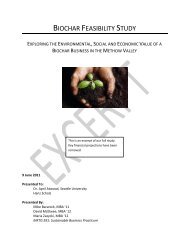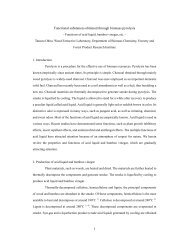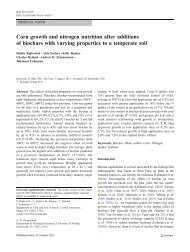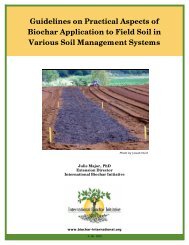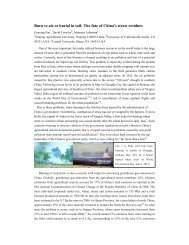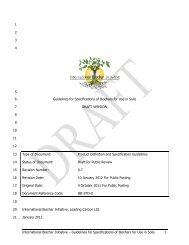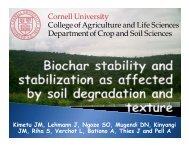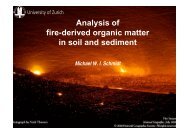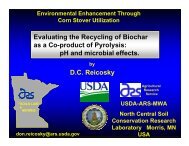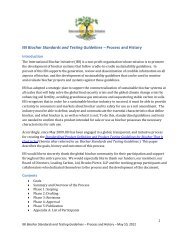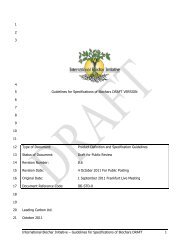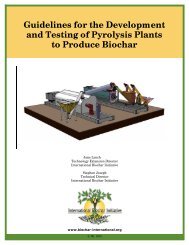Standardized Product Definition and Product Testing Guidelines for ...
Standardized Product Definition and Product Testing Guidelines for ...
Standardized Product Definition and Product Testing Guidelines for ...
Create successful ePaper yourself
Turn your PDF publications into a flip-book with our unique Google optimized e-Paper software.
1<br />
2<br />
3<br />
4<br />
5<br />
6<br />
7<br />
8<br />
9<br />
10<br />
11<br />
12<br />
These Biochar <strong>Guidelines</strong> identify three categories of tests <strong>for</strong> biochar materials:<br />
Test Category A – Basic Utility Properties: Required <strong>for</strong> all biochars. This set of tests<br />
measures the most basic properties required to assess the utility of a biochar material<br />
<strong>for</strong> use in soil.<br />
Test Category B – Toxicant Assessment: Required <strong>for</strong> all biochars. Biochars made<br />
from processed feedstocks must be tested more frequently than biochars made from<br />
unprocessed feedstocks, as defined in Section 6, <strong>Testing</strong> Protocols.<br />
Test Category C – Advanced Analysis <strong>and</strong> Soil Enhancement Properties: Optional <strong>for</strong> all<br />
biochars. Biochar may be tested <strong>for</strong> advanced analysis <strong>and</strong> enhancement properties in<br />
addition to meeting test requirements <strong>for</strong> Category A. All tests in Test Category C are<br />
optional. Producers may report on none, one, some or all of the properties.<br />
Further details on each of the test categories are provided in the following subsections.<br />
13<br />
14<br />
15<br />
16<br />
17<br />
18<br />
19<br />
20<br />
21<br />
22<br />
23<br />
4.1 Test Category A – Basic Utility Properties<br />
All biochar must be tested <strong>for</strong> basic utility properties <strong>and</strong> meet the criteria specified under Test<br />
Category A, as shown in Table 1 below. Basic biochar characteristics include the physical<br />
properties of particle size <strong>and</strong> moisture, as well as the chemical properties of elemental<br />
proportions [Hydrogen (H), Carbon (C), <strong>and</strong> Nitrogen (N)], ash proportion, Electrical<br />
Conductivity (EC) <strong>and</strong> pH/liming ability. Organic carbon content (C org ) is used to assign the<br />
biochar material to a Class that is dependent on the percentage of C org in the material. Carbon<br />
stability is indicated by the molar ratio of hydrogen to organic carbon. Lower values of this ratio<br />
are correlated with greater carbon stability. See Appendix 5, The Use of H:C org to Indicate C<br />
Stability, <strong>for</strong> more in<strong>for</strong>mation on this analysis.<br />
24<br />
<strong>St<strong>and</strong>ardized</strong> <strong>Product</strong> <strong>Definition</strong> <strong>and</strong> <strong>Product</strong> <strong>Testing</strong> <strong>Guidelines</strong> <strong>for</strong> Biochar That Is Used in Soil 11



